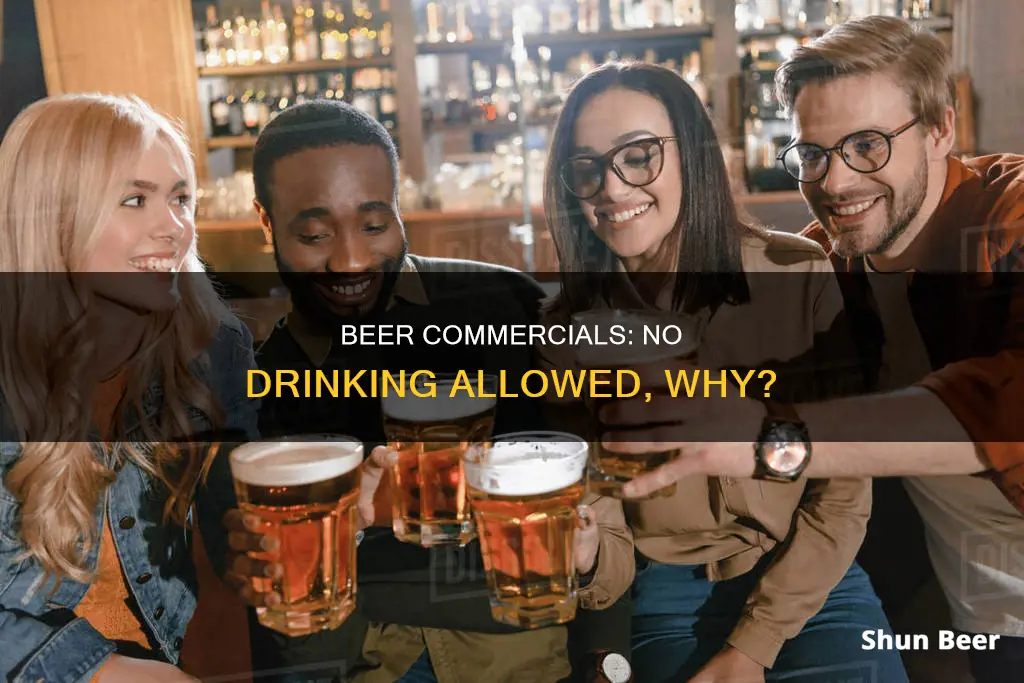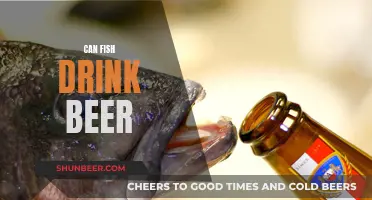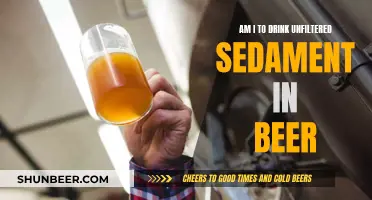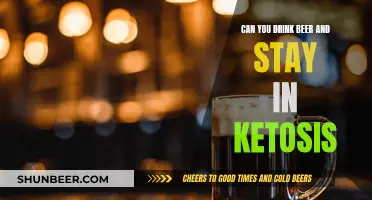
Beer commercials are a common feature of advertising, but one thing you won't see is someone actually drinking the beer. This is due to a long-standing, unofficial agreement between advertisers and TV stations/channels, which is not legally binding but is a condition of having the commercial aired. While there is no government rule or law against it, each network self-regulates, and brewers are loath to take chances with network policy. This is not the case in all countries, however, as in the UK, Germany, and Australia, people are shown drinking beer in commercials.
| Characteristics | Values |
|---|---|
| Legality | No law against it |
| Regulatory body | Television networks |
| Reasoning | To avoid stirring things up and risking a cry for a new law |
| Actors | Must be a minimum of 25 years old (unless they're famous) |
What You'll Learn
- Beer commercials are banned from showing alcohol consumption in some countries
- In the US, beer ads can only be placed in media where 71.6% of the audience is over the legal drinking age
- Beer companies were the first to adopt a self-regulatory standard for television advertising in the 1950s
- Actors in beer commercials must be a minimum of 25 years old, unless they're famous
- Beer advertising is one of the most highly regulated forms of marketing

Beer commercials are banned from showing alcohol consumption in some countries
In other countries, there are stricter rules around alcohol advertising. In the European Union, for instance, there are several restrictions on alcohol advertising, including that it:
- Must not be aimed specifically at minors or depict them consuming alcohol
- Must not link alcohol consumption to enhanced physical performance or driving
- Must not create the impression that drinking alcohol contributes to social or sexual success
- Must not claim that alcohol has therapeutic qualities or that it is a stimulant, sedative, or means of resolving conflicts
- Must not encourage immoderate consumption or present abstinence or moderation in a negative light
- Must not place emphasis on high alcoholic content as a positive quality
Some countries have taken this further, with France, Norway, Russia, Ukraine, Myanmar, Sri Lanka, Kenya, and Kazakhstan banning all alcohol advertising on television and billboards. In Malaysia, alcohol advertising on TV and radio was outlawed in 1995, and in Indonesia, it has been completely banned since the 1990s. In Australia, advertisers must follow a strict set of guidelines for showing alcohol advertisements on TV and radio, including only airing them during certain times of the day and ensuring they are not targeted at children.
Beer and Imodium: Safe Mix or Not?
You may want to see also

In the US, beer ads can only be placed in media where 71.6% of the audience is over the legal drinking age
Alcohol advertising in the US is subject to a variety of regulations and self-imposed restrictions. While there is no federal law prohibiting the depiction of alcohol consumption in commercials, the alcohol industry has historically adhered to strict self-regulatory guidelines to avoid targeting underage consumers. These guidelines are periodically reviewed by the Federal Trade Commission (FTC).
One of the key principles of responsible alcohol advertising is to ensure that marketing materials are directed only towards individuals who are of legal drinking age, which in the US, is 21 years or older. To achieve this, the alcohol industry has adopted specific targeting requirements for ad placement. Alcoholic beverage suppliers are governed by various self-regulatory organizations, each with its own advertising and marketing code.
The Beer Institute and Brewers Association, the self-regulatory organizations governing the beer industry, previously mandated that beer advertisements could only be placed in media where 71.6% of the audience was expected to be 21 or older. This threshold was based on the 2010 census data, reflecting the proportion of the population above the legal drinking age. The requirement was intended to prevent ads from disproportionately targeting younger audiences.
However, in late July 2022, the Beer Institute and Brewers Association updated their targeting standards. In response to the updated data from the 2020 census, they increased the minimum threshold to 73.6%. This means that beer advertising can now only appear in media where at least 73.6% of the audience is expected to be 21 years of age or older. This updated standard is expected to have broad implications beyond the beer industry, potentially influencing the entire alcohol industry and other industries with age-restricted products.
These self-imposed restrictions by the alcohol industry demonstrate a commitment to responsible marketing practices and ensuring their advertisements are targeted appropriately. While there is no federal law prohibiting the depiction of alcohol consumption in commercials, alcohol brands choose to adhere to these stringent guidelines to avoid targeting underage individuals.
Beer Drinking on New Jersey Transit: What's Allowed?
You may want to see also

Beer companies were the first to adopt a self-regulatory standard for television advertising in the 1950s
The Beer Institute's code is voluntary and designed to reduce underage targeting in alcohol marketing. It is monitored by an independent review board, and all members must agree to follow the code as a condition of membership. The code covers a range of topics, including the responsible portrayal of beer, the intended target group of adults of legal drinking age, and the avoidance of indecent or obscene representations.
While the Beer Institute's self-regulatory code has been praised as a model of self-regulation, it has also faced scrutiny and criticism. Studies have found that the sections governing acceptable content are ambiguous and difficult to interpret, and the complaint and adjudication process has been deemed inefficient and biased in favor of industry interests. Despite these limitations, the Beer Institute's code remains a significant aspect of the alcohol industry's self-regulation efforts.
In addition to the Beer Institute's efforts, the alcohol industry as a whole has implemented self-regulatory measures to discourage underage drinking. Three major alcohol supplier trade associations, the Distilled Spirits Council of the United States (DISCUS), the Beer Institute (BI), and the Wine Institute (WI), have voluntarily adopted regulations to address this issue. These regulations include standards for ad placement and content to ensure that alcohol advertising does not appeal to or target audiences under the legal drinking age.
Pigs and Beer: A Curious Combo
You may want to see also

Actors in beer commercials must be a minimum of 25 years old, unless they're famous
The Beer Institute, established in 1938, has a long history of its Advertising and Marketing Code being amended to meet evolving social, commercial, and technological conditions. In 2015, the institute updated its code to clarify the age requirements for models and actors employed to appear in beer advertising and marketing materials. While models and actors must be a minimum of 25 years old and appear to be of legal drinking age, the 25-year provision does not apply to generally recognizable athletes, entertainers, and other celebrities who are of legal drinking age.
The Beer Institute's code is voluntary and serves as a model of self-regulation. In 2014, the Federal Trade Commission (FTC) reaffirmed the success of this model, stating that self-regulation of alcohol marketing helps reduce underage targeting. All members of the Beer Institute agree to follow the code and respect the decisions of an independent review board as a condition of membership.
The age requirement for actors in beer commercials is not a legal mandate but rather an industry-imposed standard. While there are no government rules specifically prohibiting actors under 25 from appearing in beer commercials, the self-regulation by the beer industry helps ensure that its advertising does not target underage individuals.
The beer industry's self-regulation extends beyond just the age of actors in commercials. For example, beer companies were the first to adopt a self-regulatory standard for television advertising in the 1950s. More recently, the Beer Institute's code has been amended to address internet privacy and social media concerns. Additionally, the code now allows any identified individual, company, or organization to file a complaint about any brewer's advertising, including competitor complaints.
By adhering to these self-regulatory standards, the beer industry can maintain a degree of control over its advertising practices and avoid more restrictive government intervention. As noted by a spokeswoman for The Beer Institute, brewers have no desire to stir things up and risk stirring a cry for a new law. The self-regulation also allows the industry to adapt its advertising and marketing practices to evolving social and technological changes while still prioritizing responsible practices.
Beer and Coke: A Match Made in Heaven?
You may want to see also

Beer advertising is one of the most highly regulated forms of marketing
The TTB outlines specific requirements for advertisements of malt beverages and beer, wine, and distilled spirits. For example, advertisers must include the class the product belongs to (e.g. ale, stout, lager, etc.), the name and address of the advertiser, the type and class of the product, and the alcohol content listed as a percentage by volume. There are also several things that are prohibited from being included in alcoholic beverage advertisements, such as misleading or false statements, indecent or obscene representations, guarantees of health benefits, and promotions or discounts.
In addition to federal regulations, many states have their own specific rules and regulations regarding the marketing and advertising of alcoholic beverages. For example, some states have regulations about the placement of print advertisements for alcohol, requiring them to be at least 500 feet away from schools, public playgrounds, and churches. States may also have rules about the number of drinks that can be sold to a person or group for a fixed price, and promotional events are often discouraged by state regulations.
While there is no federal law prohibiting the depiction of alcohol consumption in advertisements, it is considered an unofficial ban based on previous agreements, codes of conduct, and network guidelines. The Beer Institute, the voice of brewers, has stated that its members are reluctant to take chances with network policy and will therefore be as conservative as possible to ensure their commercials air.
Overall, the highly regulated nature of beer advertising reflects the government's and industry's commitment to responsible marketing and addressing public health concerns associated with alcohol consumption.
Beer and Coffee: A Match Made in Heaven?
You may want to see also
Frequently asked questions
It is an unofficial ban based on previous agreements, codes of conduct, and network guidelines.
Alcohol advertising in the US is self-regulated by the industry. The standard is that alcohol ads can only be placed in media where 71.6% of the audience is over the legal drinking age.
Yes, some countries such as France, Norway, Russia, Ukraine, Myanmar, Sri Lanka, Kenya, and Kazakhstan have banned all alcohol advertising on television and billboards.
Scientific research has demonstrated a correlation between alcohol advertising and consumption, especially among initially non-drinking youth. There is also criticism that alcohol advertising targets young people and contributes to underage consumption and binge drinking.
Yes, according to the Beer Institute's Advertising and Marketing Code, actors must be a minimum of 25 years old and appear to be of legal drinking age. However, this 25-year-old provision does not apply to recognizable athletes, entertainers, and celebrities who are of legal drinking age.







